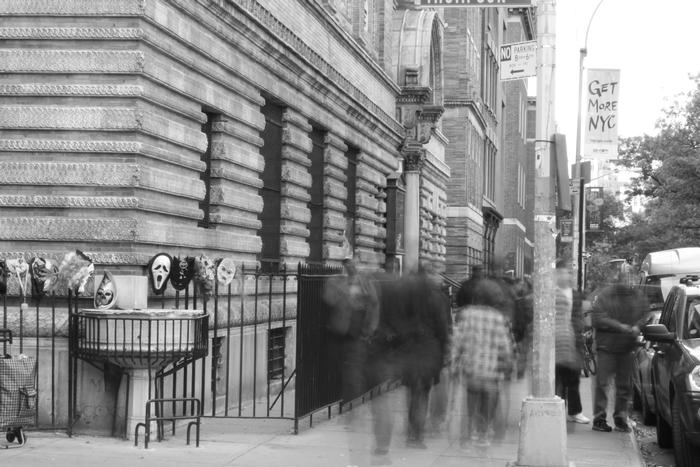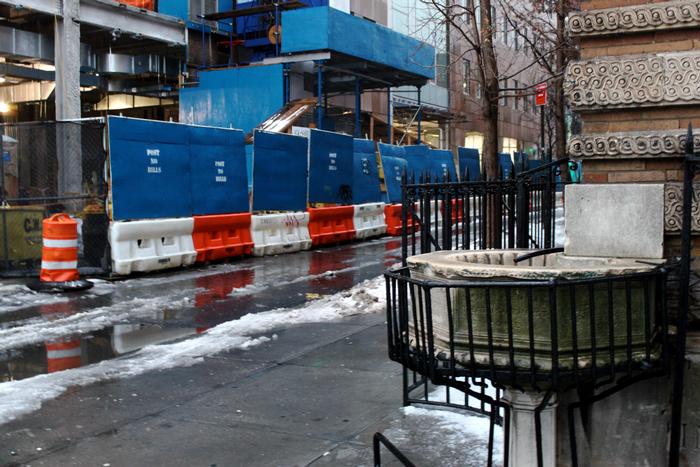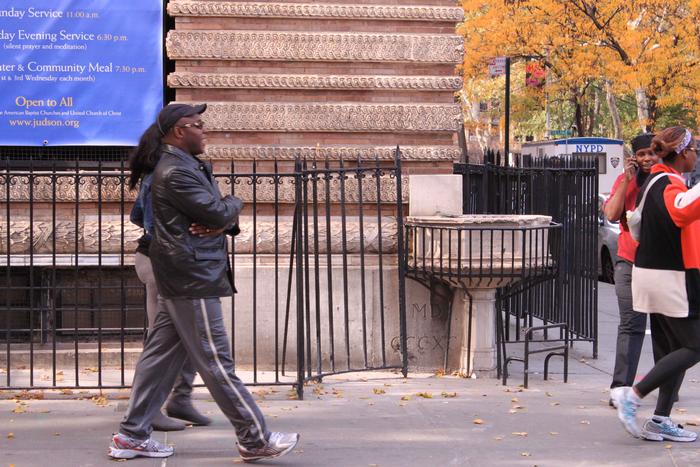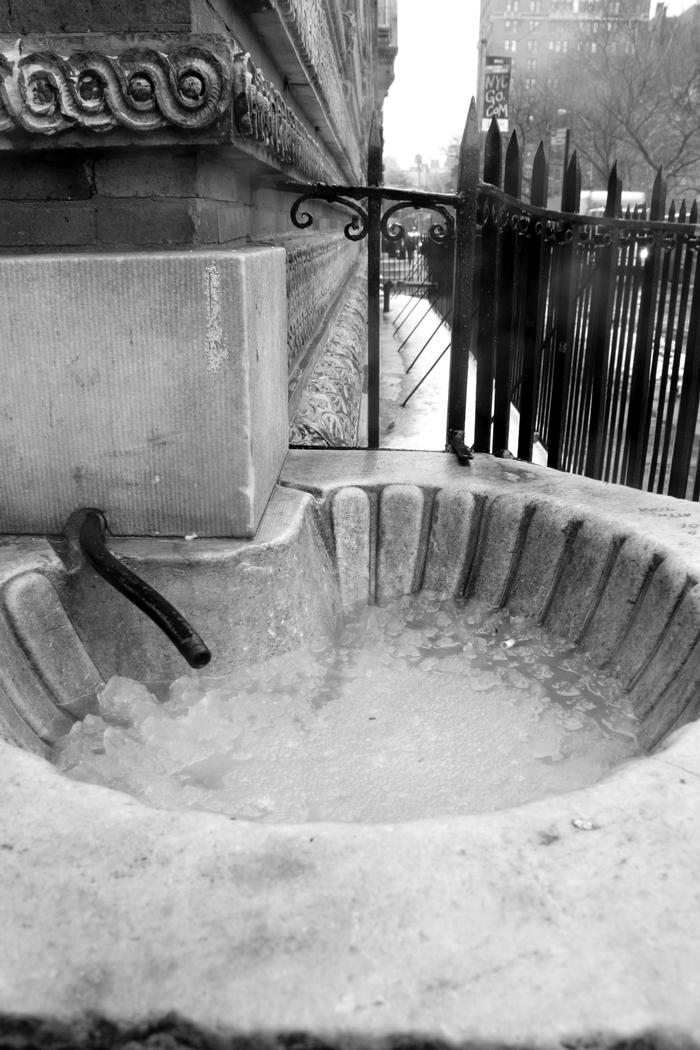[ID:45] Hirst, Water, and the Need to Make Art from Public FountainsUnited States Almost four years ago, in June of 2007, the following headline appeared on BBC News: “HIRST UNVEILS £50 DIAMOND SKULL.” For the Love of God, the platinum cast of an 18th-century skull encrusted with 8,601 diamonds, was, and still is, an Internet and social sensation. Damien Hirst, its creator and Britain’s wealthiest artist, has easily become one of the art market’s most recognizable faces, despite his many critics who feel his work—dead sheep, sharks soaked in formaldehyde—is shallow and derivative.
Yet there is a salient story to be told through this extravagant object, and it is one that reflects not only our social behavior, but also what much of society considers to be valuable. The global recession that, ironically, immediately followed the sale of For the Love of God put into question these hyper-consumptionist tendencies. The media blitz around this artwork was proof that it was, indeed, a sign of the times and a well-timed execution of a worldwide trend in excess. After all, the centerpiece of Hirst’s creation was a 52.40-carat pink diamond, set in the skull’s forehead (BBC News).
Art is expensive. And diamonds are rare. Combine the two, and you figure it’s only a matter of time before someone capitalizes on this dynamic. But Adam Smith, in The Wealth of Nations, provides a critical paradox that challenges what we might have considered to be rather ordinary. As he points out, water is essential for life, and the value of diamonds is mostly aesthetic, but the price of water has always been far lower than that of diamonds. The conscious, rational mind could compute water’s importance over its flashy obverse, but it’s something about the ubiquity of water—a seemingly endless resource—that devalues the former and convinces us that a shiny allotrope of carbon is actually useful. I’d like to think we could unhinge ourselves from this trick of the mind, but we’re still years away from replacing the conventional ring with a carafe of drinking water to sanctify marriage. Even saying this aloud makes me question my sanity.
While auction houses such as Sotheby’s in New York were busy scoffing at the unorthodoxy of London’s White Cube Gallery and the exorbitant price tag of Hirst’s “Beyond Belief” show, which included the diamond skull, another group was conducting a quantitative assessment of its own. In 2007, New Yorkers for Parks meticulously documented key service areas—bathrooms, playgrounds, seating, etc.—in the five boroughs’ neighborhood parks (NY4P). Their Report Card on Parks highlighted the inadequate attention New York’s smaller public spaces receive and tried to assign a numerical value to these indicators of urban quality of life. In doing this, you could say the universal grading system—A, B, C and so forth—they used was an attempt to make the dilapidation of these outdoor communal spaces relatable to everyone. Just as the price in dollars and the weight in carats of a gem could signify its exceptional worth, so, too, could a B+ or a D- communicate the valuation of something as common as a lawn or a playground.
Of the forty-two parks in all five boroughs (Manhattan, Brooklyn, Queens, the Bronx, and Staten Island) that received a grade of “D” or “F”, an astonishing 94% of them failed to have drinking fountains that function (NY4P). Our perception of these vehicles for water, it seems, has devolved into one of distrust and liability. As we see them, they are too unhygienic to stop at, and they would take too much time to repair.
Why is that? How is it that New York, one of the wealthiest cities in the United States, fails to provide efficient distribution of public access to clean, drinking water? We’ve got to face the cold truth that most people consider every other building, shop, restaurant, or outdoor space that can generate revenue to outweigh the importance of something as monetarily devoid as a water fountain. If For the Love of God was the Jackson Pollock of investments, then an urban drinking fountain is the early Picasso sketch—undocumented, unappreciated, with an invisible value.
About six months ago, on a sultry August day, I was walking along my normal route to class at New York University in Greenwich Village. The stretch from Sixth Avenue to Washington Square East (my final destination) on West Fourth Street is a familiar and necessary segment of this journey. I always look forward to these few blocks, because I am convinced I will run into a friend or professor. While this doesn’t always happen, the feeling is rooted in my comfort with this street. It has seen me grow, and I watch as NYU adds new buildings almost yearly, but we are closely acquainted. We’ve changed simultaneously, so this awareness of other is mutual. So I believed.
On the northeast corner of West Fourth and Thompson Streets, it occurred to me that I hadn’t been as acute with my surroundings as I had thought. It was only when I was planning to make a detour to the Kimmel Center, an NYU-owned academic and cultural center, to get a drink from one of their many water fountains that I realized that the stone pedestal and basin sandwiched between two fences could have once served the same function. Had I not been a paying student at this institution, my thirst would have gone unquenched that day. Maybe that’s what it would have taken for me to recognize this small monument on my countless other saunters to school.
I sat in Fales Archives, at NYU’s Bobst Library, and read about the history of the Duncan Dunbar Memorial Fountain. The extension of this vital resource of fresh, chilled drinking water, I learned, began on September 20th, 1891. On this day, a ceremony took place to unveil and inaugurate the ice-water fountain at the northeast corner of the McKim, Mead and White-designed Judson Memorial Church (NY Times). For the largely Italian immigrant community of the South Village, the main recipient of this lifeline, the church instilled a heightened level of awareness. Its users, mindful of water as an elemental necessity, could extract some semblance of inclusive citizenship through this Italianate white marble sculpture—breast-high and complete with a spigot and step—on the very same corner on which I finally stopped just a few weeks prior.
Because immigrants in the South Village could not afford ice in the sweltering summer, the water, cooled by a coil of pipe laid in ice, was celebrated by the community. According to a photo, children crowded the fountain, using its hexagonal base and basin to facilitate six-person games. Even late into the night, cool water was carried away to tenement houses to prepare communal dinners.
I discovered that the Duncan Dunbar Memorial Fountain was one of only five public ice-fountains installed under the Fresh Air, Cool Water, and Flower Fund. “Thousands drink from it daily,” a Fresh Air and Cool Water pamphlet from 1901 asserts (Fales). The high demand for potable water relied on regular donations from families such as the Vanderbilts, so private donors, as they are today, were necessary to continue this public service. But even their faith in the utility of the fountain faltered in time. To the dismay of Greenwich Village, the Duncan Dunbar Memorial Fountain—underfunded and under physical stress—closed in the early 1950s.
I could blame myself for not deciphering the fountain’s complicated past, but there’s something about its location and appearance that conceals these truths. Street corners are place-markers. By the time we look up at the street name, situate ourselves, and calculate our estimated arrival time to wherever we’re headed, that intersection is long gone from our sight and memory. Occasionally, we wait for traffic, but we even lack the patience to wait for the “walk” signal. New Yorkers are notorious for jaywalking. We are convinced there’s no reason to stay or linger and, thus, urban nooks become a blur in our minds.
This specific cranny is veiled by the black iron balustrade that parallels both the north and east facades of the church. They do not meet, and a four-foot wide opening allows the fountain room to breathe; however, this protective material conforms to every angle of the polygonal water vessel, too, guarding its entire face. The only visible conductor of information on this monument, the proverb inscribed on each forepart of the six-sided basin, is even locked away. These limitations, our mind tells us, produce an aura of invisibility.
In an age of social networking that sometimes takes place in nanoseconds, our attention spans are shorter than ever. We like to be stimulated in a visual or auditory manner as quickly as possible, and if that synaptic exchange falters in speed, we become less interested. Hence, the immediate satisfaction of something new; something shiny; something expensive; something Hirst.
Water should not have to be reduced to these same techniques in order to make itself seen, but we are all guilty of ascribing more value to things that cost more. New Yorkers pay separately for electricity, but water is subsumed under the rent paid monthly. At a cost of $2.31 per 748 gallons, water services in New York City are seriously underpaid for (DEP NYC). But any hike in the rate, any attempt to appreciate its value, would be met with fierce opposition. Only the bottled water industry has been successful in fooling us. Most would pay $2.31 for just two cups of packaged water. We really are a consumerist society.
The anthropologist Kelly D. Alley has documented water’s centrality to life through the Ganges River in India. Though it is polluted by industrial, household and urban waste, Hindus in northern India “worship her as a purifier, goddess, and mother” (Alley 17). Ritual ablutions take place yearly in the Ganges, at various points along the 1,560-mile-long system of headstreams and tributaries. But whether Ganga (the river in goddess form) devotees connect with this watershed in Haridwar, Allahabad, Varanasi, or Kolkata, they are aware of this holy site as part of a larger geographical order, and even a larger cosmic order.
In my readings of this ethnology, it strikes me that New York has an unusually clean water supply given its population density, yet we do not commemorate this enough. Our sources of water—from the Catskill/Delaware System 125 miles northwest of the city, from the Croton System a slightly shorter distance away—will be treated by a $2.8 billion water filtration plant beneath Van Cortlandt Park in Queens and an Ultraviolet Disinfection Facility, capable of disinfecting 2,020 million gallons per day of the clear liquid in the next couple of years (NYC DEP). But in the end, water only cleans us, nourishes us, keeps us immune from diseases like yellow fever, and contributes to the production of any tangible thing. It does not, however, entertain us, stimulate our brain, or induce pleasure.
A few weeks ago I attended a lecture on both the High Line and High Bridge at the Center for Architecture near Washington Square. The former is the highly acclaimed elevated railroad that spans from the Meatpacking District to West Chelsea, recently re-purposed into a public park. Not only does it offer gourmet food stands, ample seating, public restrooms, art installations, and seasonal events, it has also sparked an impromptu performance: a woman dressed in drag, protesting construction noises and lights. She called this ‘renegade cabaret’. This ad hoc display developed into a weekly performance, with city denizens planning their trip to coincide with her provocative show. You could say this is the paragon of civic infrastructure as culture.
The planned and spontaneous programs at the High Line shape the time spent there; the time spent increases appreciation. This rule of thumb, too, can work for a broken fountain.
Our problem with engaging the built environment’s history can be reduced to two basic frustrations: it’s too academic, and it’s too dry. I hear this frequently when trying to justify why I become so excited at the sight of a decaying pier on the Hudson River or a timeworn, marble pedestal and basin that was once used to dole out drinking water. It’s not that I enjoy disrepair, but rather I marvel at the information and experience that a deck rusted with iron oxide, or a broken spigot must contain. If there is potential in a monument or site such as these, somehow we have disguised it. The mundaneness we have ascribed to matters of historical significance is not some inherent quality of these physical vestiges of previous generations, but rather our failure to make them relevant to our modern day.
We already have places that are sacred; they channel knowledge through us and communicate a historical or social pattern at a much larger scale. It is not that a new space needs to be created on the corner of West Fourth and Thompson Streets, but rather we need to allot that space so that something free, something open, and something that harks back to a specific people and period in history can be experienced as sacred today and in the future.
On a large, white sheet of paper, with a photo of the fountain, I trace its form—cracks, blemishes, and all—with pencil. I sketch the reconfiguration of its piping to the basement. With a precise, circular motion, the blemishes are now removed. I pretend my erasing is the pressure cleaning that the marble requires for its inscriptions to become observable. I fill in the cracks in the fountain’s basin, imagining it to be epoxy injections. I blot out the wrought-iron barricade that encases it. It is exclusive, I think to myself, and this fountain needs to invite. Making swooping, curve-like strokes, I connect the fence on the left, with the fence on the right, and repeat hundreds of times. I cover the fountain from view and extend the lead’s marks upwards past the sculpture four or five feet. “Yarn,” I say aloud. I could engulf this entire alcove in a bright, yellow yarn, resembling a cocoon. It is said that habituation tends to gradually abate our excitement about a place or thing. If this is the product of our constant adjustment to our surroundings, we need something that breaks our familiarity with our milieu. A big, yellow hair-like cocoon can do that, temporarily. Two weeks should pass, then I would remove it. An installation, of sorts.
I sketch an awning. It’s free-standing so it does not touch the delicate limestone of the church’s northeast façade corner, yet it still provides protection from sun, snow, and rain. The public could use this as a street marker, a meeting place. Even chance encounters could be produced here. Making a narrow, cylindrical form and attaching it onto the only externally extruding pipe, I draw a transparent continuation of it, and affix it to an outline I have just produced of a large, translucent tank that can hold a day’s worth of water and that stands on the ground. We do not have to be removed from our natural needs, even if we do live in the developed world, unless we choose to. Through this connection, we can measure our consumption and track a brief section of the distance our water traverses daily. Then I make my final mark: the tank needs an output, so I follow the distance from the bottom edge of the see-through liquid receptacle, making a 90-degree turn upwards toward the basin, and then replicating my previous move, but this time over the drain itself. I stop. Diverting this pipe into a fork, I point one opening up and the other down. I envision humans without bottles for the first; I consider humans with bottles, or dishes for their pets, for the second.
Relieved, drawing completed, I fill up a glass of water from the tap in my apartment. I ponder the diamond skull, the statistics of New York’s drinking fountains, and why I am such a hydrophile. When I was a child, I devised different ways of drinking, carrying and filtering water. I tried to imbibe it with straws, cups, canteens, bowls (not too successfully), and bags. For some reason, I’ve yet to grow bored of this chemical substance (H20 is its chemical formula). Now, as an adult, I want to use this idiosyncrasy to cultivate an entirely different viewpoint about our forgotten carriers of water. If Damien Hirst’s idea is to dress up the dead, then I propose to enhance something that once sustained life. Maybe then, we could equate the Duncan Dunbar Memorial Fountain with its extravagant counterpart.
Works Cited
"A Drinking Fountain Unveiled." The New York Times 21 Sept. 1891. Web. 17 Oct. 2010.
Alley, Kelly D. On the Banks of the Ganga: When Wastewater Meets a Sacred River. Ann Arbor: University of Michigan, 2002. Print.
"BBC NEWS | Entertainment | Hirst Unveils £50m Diamond Skull." BBC News - Home. Web. 02 Jan. 2011.
"Fresh Air, Clean Water, and Flower Fund Pamphlet." 1910. MS. Fales Library and Special Collections-New York University, New York, NY. Series F: Early Church History (Accretion 2001), Subseries 3: Church Histories, Box 11, Folder 16
"New Yorkers For Parks - The Report Card on Parks Project." New Yorkers For Parks - Home. Web. 14 Nov. 2010.
"NYC DEP 2009 Drinking Water Supply and Quality Report." Web. 15 Jan. 2011.
Photograph. Fales Library and Special Collections-New York University, New York, NY. Judson Memorial Church Archive MSS 094 Series B: Building, Subseries 1, Box 17, Folder 47
Smith, Adam, and Edwin Cannan. The Wealth of Nations. New York: Modern Library, 2000. Print.
If you would like to contact this author, please send a request to info@berkeleyprize.org. |




